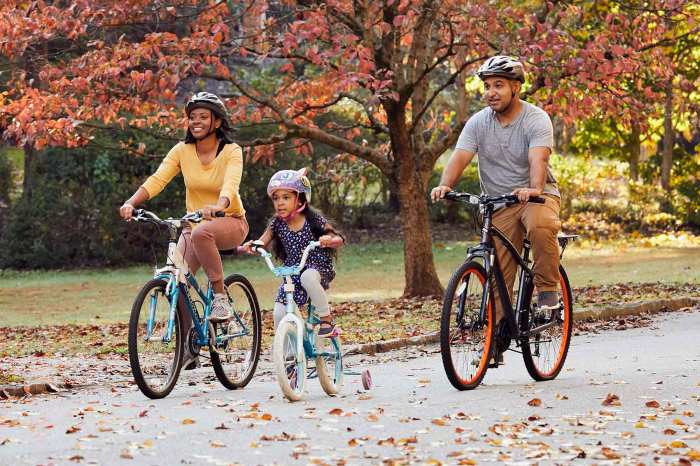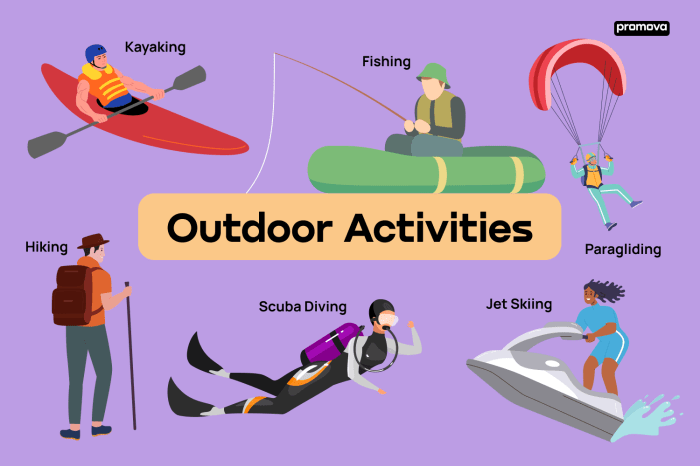Outdoor Hobby participation is booming, reflecting a societal shift towards nature and wellness. From the tranquil pursuit of birdwatching to the adrenaline rush of rock climbing, the diversity of outdoor activities caters to a wide range of interests and fitness levels. This guide delves into the popularity, types, equipment, environmental impact, safety, community aspects, and even the photographic opportunities inherent in this growing trend.
We explore everything from cost considerations and choosing the right hobby to minimizing environmental impact and maximizing safety.
Understanding the nuances of each outdoor pursuit, from the low-impact serenity of hiking to the high-intensity demands of white-water rafting, requires careful consideration. This exploration examines the essential equipment, responsible practices, and community connections that enrich the experience. Whether you’re a seasoned adventurer or a curious beginner, this guide offers valuable insights to help you find your perfect outdoor passion.
Types of Outdoor Hobbies

The pursuit of outdoor hobbies offers a diverse range of activities catering to various fitness levels, interests, and budgets. Categorizing these pursuits based on activity level and equipment needs provides a framework for individuals seeking to engage in enriching outdoor experiences. Understanding the benefits and drawbacks associated with each category is crucial for making informed choices.
Categorizing Outdoor Hobbies by Activity Level and Equipment
Outdoor hobbies can be broadly classified based on their intensity and the resources required. Low-impact activities typically involve less strenuous physical exertion and minimal equipment, while high-impact activities demand greater physical fitness and often necessitate specialized gear. This categorization aids in matching individual preferences and physical capabilities with suitable pursuits.
Low-Impact Outdoor Hobbies
Low-impact activities are ideal for individuals seeking gentle exercise and relaxation in nature. These pursuits often require minimal equipment and can be enjoyed by people of various fitness levels.
- Birdwatching: This hobby involves observing birds in their natural habitat. It requires minimal equipment, primarily binoculars and a field guide, and offers a tranquil escape into nature. Benefits include stress reduction, improved observation skills, and connection with the natural world. Drawbacks may include unpredictable weather conditions and the need for patience and stillness.
- Nature Photography: Capturing the beauty of the natural world through photography allows for creative expression and appreciation of nature’s details. Equipment needs vary, from simple point-and-shoot cameras to advanced DSLR systems. Benefits include artistic fulfillment, improved observation skills, and the creation of lasting memories. Drawbacks can include the need for technical expertise and the potential for unpredictable weather conditions to impact photo opportunities.
- Hiking (leisurely): Gentle walks on established trails offer a low-impact way to enjoy the outdoors. Minimal equipment, such as comfortable shoes and water, is needed. Benefits include improved cardiovascular health, stress reduction, and exposure to fresh air and sunshine. Drawbacks might include limited calorie burn compared to more strenuous hikes and potential for boredom on repetitive trails.
High-Impact Outdoor Hobbies, Outdoor Hobby
High-impact activities demand significant physical exertion and often require specialized equipment. These pursuits offer a more intense workout and a greater sense of accomplishment.
- Rock Climbing: This challenging activity requires strength, endurance, and technical skill. Specialized equipment, including climbing shoes, harness, ropes, and carabiners, is essential. Benefits include significant strength gains, improved cardiovascular health, and a sense of accomplishment. Drawbacks include a higher risk of injury and the need for proper training and safety precautions.
- Mountain Biking: Navigating challenging terrain on a mountain bike provides a vigorous cardiovascular workout and exciting outdoor adventure. Equipment includes a mountain bike, helmet, and protective gear. Benefits include improved cardiovascular fitness, strength building, and exploration of diverse landscapes. Drawbacks include the potential for injury and the need for mechanical skills to maintain the bike.
- Backpacking/Trekking: Multi-day hiking trips involving carrying all necessary gear demand high levels of physical endurance and planning. Equipment includes a backpack, tent, sleeping bag, cooking supplies, and appropriate clothing. Benefits include a deep connection with nature, a sense of accomplishment, and improved physical fitness. Drawbacks include the need for extensive planning, physical endurance, and potential exposure to the elements.
Choosing an Appropriate Outdoor Hobby: A Decision-Making Flowchart
A simple flowchart can assist in selecting an appropriate outdoor hobby based on individual preferences and capabilities.
The flowchart would visually represent a decision tree. Starting with the question “What is your desired activity level?”, branches would lead to “Low-impact” or “High-impact”. Further branches would stem from these options, considering factors such as equipment requirements, budget, and personal interests. Each end point would suggest a specific hobby aligned with the chosen criteria. For example, a low-impact, low-equipment, nature-loving individual might be directed to birdwatching, while a high-impact, equipment-tolerant, adventurous individual might be guided towards rock climbing.
Equipment and Gear for Outdoor Hobbies: Outdoor Hobby

Choosing the right equipment is paramount for a safe and enjoyable outdoor experience. The necessary gear varies significantly depending on the chosen activity, ranging from lightweight essentials for a casual hike to specialized and potentially expensive equipment for mountaineering or white-water rafting. Proper equipment selection directly impacts performance, comfort, and crucially, safety.
Essential Equipment by Activity
The selection of essential equipment depends heavily on the specific outdoor hobby. A comprehensive list for every activity is beyond the scope of this piece, but examples for several popular pursuits illustrate the principle. For hiking, essential items include sturdy hiking boots, a backpack with sufficient capacity, appropriate clothing layers for varying weather conditions, navigation tools (map, compass, GPS), a first-aid kit, water, and high-energy snacks.
Rock climbing demands specialized equipment such as climbing shoes, a harness, ropes, carabiners, and belay devices, requiring significant investment and training. Kayaking or canoeing necessitates a watercraft appropriate for the water conditions, a paddle, a personal flotation device (PFD), and waterproof storage for valuables. Camping adds a tent, sleeping bag, cooking equipment, and lighting to the list.
Safety Gear and Risk Mitigation
Safety gear is not merely a suggestion; it’s an investment in personal well-being. For hiking, this includes sturdy boots to prevent ankle injuries, and a brightly colored jacket to increase visibility. In water sports, a personal flotation device (PFD) is non-negotiable, and a whistle is crucial for signaling in emergencies. For climbing, a helmet protects against falling rocks and equipment malfunctions.
The impact of safety gear on risk mitigation is undeniable; appropriate gear can significantly reduce the likelihood of injury or even death in many outdoor activities. For instance, a helmet dramatically decreases the risk of head trauma in rock climbing or cycling. Similarly, a properly fitted PFD can be life-saving in kayaking or boating.
Cost and Performance Comparison of Outdoor Equipment Brands
The market offers a wide range of outdoor equipment brands, each varying in cost and performance. High-end brands often utilize superior materials and construction techniques, resulting in increased durability and performance, but at a higher price point. For example, premium hiking boots from brands like Salomon or Scarpa generally offer superior comfort, support, and longevity compared to budget options, though the price difference can be substantial.
Similarly, high-end tents from brands like Big Agnes or MSR are often lighter, more durable, and more weather-resistant than cheaper alternatives. However, many budget-friendly brands offer acceptable performance for less demanding activities or occasional use. The optimal choice depends on individual needs, budget, and frequency of use. Consider the trade-off between cost and performance before purchasing.
Maintenance Tips for Common Outdoor Equipment
Regular maintenance prolongs the lifespan and performance of outdoor equipment.
- Hiking Boots: Clean mud and debris after each use, allow to air dry, and apply waterproofing treatments as needed.
- Backpacks: Clean with mild soap and water, air dry completely, and check straps and buckles for wear.
- Tents: Allow to completely dry before storing to prevent mold and mildew. Repair any tears promptly.
- Sleeping Bags: Air out regularly and store loosely in a breathable bag. Follow manufacturer’s cleaning instructions.
- Climbing Gear: Regularly inspect ropes, harnesses, and carabiners for wear and tear. Replace any damaged items immediately.
Environmental Impact of Outdoor Hobbies

The burgeoning popularity of outdoor recreation presents a complex relationship with the environment. While connecting with nature offers significant mental and physical health benefits, the sheer volume of participants and the activities themselves can exert considerable pressure on ecosystems. Understanding this impact and adopting responsible practices are crucial for ensuring the long-term sustainability of both our outdoor pursuits and the natural world.
Environmental Impacts of Specific Outdoor Activities
Different outdoor activities carry varying degrees of environmental impact. Hiking, for instance, can lead to trail erosion and habitat disturbance, particularly on heavily trafficked paths. Camping, even with minimal impact practices, can contribute to soil compaction and waste generation. Water-based activities like kayaking or boating can disrupt aquatic ecosystems through noise pollution, oil spills, and the introduction of invasive species.
Mountain biking, if not managed carefully, can cause trail damage and habitat fragmentation. Rock climbing, particularly in sensitive areas, can contribute to rock erosion and disturb nesting birds or other wildlife. These impacts are amplified by the increasing number of participants in these activities.
Responsible Practices for Minimizing Environmental Footprint
Minimizing the environmental impact of outdoor hobbies requires a multi-pronged approach. The Leave No Trace principles provide a comprehensive framework for responsible outdoor recreation. These principles emphasize planning and preparation, staying on marked trails, disposing of waste properly, leaving what you find, minimizing campfire impacts, respecting wildlife, and being considerate of other visitors. Beyond Leave No Trace, adopting sustainable transportation methods, such as biking or carpooling, can significantly reduce carbon emissions associated with travel to outdoor locations.
Eco-Friendly Outdoor Gear and Sustainable Practices
The outdoor gear industry is increasingly focused on sustainability. Many companies now offer clothing and equipment made from recycled materials, such as recycled polyester or organic cotton. Durable, high-quality gear reduces the need for frequent replacements, minimizing waste. Choosing gear made with responsibly sourced materials, such as sustainably harvested wood for trekking poles or recycled aluminum for cookware, further contributes to environmental protection.
Supporting businesses committed to ethical manufacturing practices and environmental responsibility also plays a vital role. Furthermore, repairing damaged gear instead of immediately replacing it extends its lifespan and reduces the demand for new products.
A Guide for Minimizing Waste and Pollution During Outdoor Activities
Before embarking on any outdoor activity, planning is essential. This includes packing out all trash, even biodegradable items, to prevent pollution and habitat disruption. Carrying reusable water bottles, food containers, and utensils reduces reliance on single-use plastics. Using biodegradable soap and toiletries minimizes the impact on water sources. Properly disposing of human waste is crucial, particularly in areas lacking sanitation facilities.
Utilizing portable waste disposal systems or burying waste according to Leave No Trace guidelines helps protect sensitive environments. Educating oneself about the specific environmental sensitivities of the area being visited is crucial for making informed decisions and avoiding potential harm. For example, avoiding sensitive plant life during hikes or selecting less-trafficked trails helps preserve biodiversity.
Photography in Outdoor Hobbies

Outdoor photography transforms passive enjoyment into active engagement, elevating the experience of numerous hobbies from a simple pastime to a richer, more creative pursuit. The act of carefully framing a shot, considering light and composition, forces a deeper connection with the environment, fostering a heightened awareness of details often overlooked. This synergy between observation and artistic expression significantly enhances the overall satisfaction derived from outdoor activities.
Enhancing Outdoor Hobby Experiences Through Photography
Photography acts as a powerful catalyst, deepening the experience of various outdoor pursuits. Hiking, for instance, becomes more than just physical exertion; it transforms into a quest for visually compelling landscapes. Birdwatching transcends mere observation, evolving into a meticulous documentation of avian life. Similarly, kayaking or canoeing offers opportunities to capture stunning reflections and unique perspectives on waterways, while rock climbing provides dramatic compositions showcasing both human achievement and the grandeur of nature.
The resulting photographs serve as lasting mementos, preserving memories and providing tangible evidence of these experiences.
Techniques and Equipment in Outdoor Photography
Successful outdoor photography requires a blend of technical proficiency and artistic vision. Essential equipment includes a high-quality DSLR or mirrorless camera with interchangeable lenses, a sturdy tripod for sharp images in low light, and a range of lenses catering to diverse subjects and distances – a wide-angle lens for landscapes, a telephoto lens for wildlife, and a macro lens for close-up shots of flora and fauna.
Essential techniques encompass understanding exposure (aperture, shutter speed, ISO), mastering focus (manual or autofocus), and employing image stabilization to mitigate camera shake. Post-processing software, such as Adobe Lightroom or Photoshop, allows for fine-tuning images, enhancing colors, and correcting imperfections.
Composition and Lighting in Outdoor Photography
Mastering composition and lighting is crucial for capturing stunning outdoor images. The rule of thirds, leading lines, and framing are fundamental compositional techniques that guide the viewer’s eye and create visual interest. Lighting conditions significantly impact the mood and quality of photographs. The “golden hour,” the period shortly after sunrise and before sunset, offers soft, warm light ideal for landscapes and portraits.
Conversely, harsh midday sun can create strong shadows and washed-out colors. Understanding how light interacts with the subject and the environment is key to achieving visually appealing results. Backlighting can create silhouettes, while side lighting emphasizes texture and form.
A Step-by-Step Guide to Photographing Landscapes and Wildlife
Capturing high-quality landscape and wildlife photographs involves a systematic approach.
- Planning and Preparation: Research the location, considering weather conditions, time of day, and potential subjects. Pack appropriate equipment, including extra batteries and memory cards.
- Composition and Framing: Utilize compositional techniques like the rule of thirds to create balanced and visually appealing images. Experiment with different angles and perspectives.
- Exposure Settings: Adjust aperture, shutter speed, and ISO to achieve optimal exposure, considering the lighting conditions and desired depth of field. Use a tripod for sharp images, especially in low light.
- Focus and Sharpness: Employ manual or autofocus techniques, ensuring sharp focus on the key subject. Use a higher f-stop for greater depth of field in landscapes.
- Post-Processing: Utilize editing software to enhance colors, adjust contrast, and correct any imperfections. Maintain a natural look and avoid over-processing.
Tips for Taking Great Nature Photos: Patience is key. Observe your subject carefully and wait for the right moment. Anticipate movement, especially with wildlife. Experiment with different compositions and lighting conditions. Don’t be afraid to break the rules; sometimes the most striking images come from unconventional approaches. Above all, enjoy the process and connect with the beauty of nature.
Embracing the world of outdoor hobbies offers a wealth of physical, mental, and social benefits. From fostering a deeper connection with nature to building lasting friendships and improving overall well-being, the rewards are significant. By understanding the various aspects explored here – from responsible environmental practices to effective safety measures – individuals can confidently embark on their chosen outdoor journey, enriching their lives and contributing to a sustainable future.
Remember, the key is to find an activity that aligns with your interests and capabilities, fostering a lifelong love for the outdoors.

